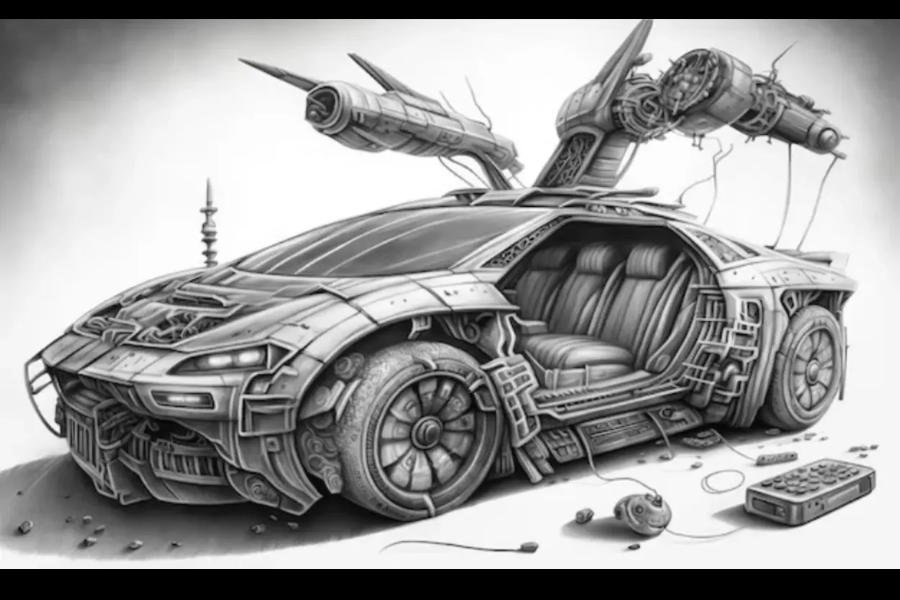Drawing automobiles offers a captivating journey into the realm of artistic expression. The sleek contours and technical intricacies of cars attract many aspiring artists, providing a canvas where art and engineering converge. With dedicated practice, one can hone their skills to realistically capture these dynamic designs on paper, enhancing both patience and attention to detail along the way.
Why Drawing Cars Captivates Us
Artists have long been captivated by automobiles because of their sharp lines and abundant symbolism, making them compelling subjects for creative expression. Every vehicle typifies a combination of class, power, and state of the art designing, offering specialists a material ready for investigation. Every automobile tells a story of human ingenuity and cultural evolution, from the sweeping lines of classic sports cars to the futuristic designs of electric cars.
Artists are drawn not only by the physical form but also by the essence of speed, luxury, and the ever-evolving relationship between humans and technology. They encourage viewers to appreciate automobiles as both artistic inspiration and technological marvels by celebrating the intricate details and emotional allure of automobiles through their drawings.
Importance of Learning to Draw Cars
Learning the fundamentals of drawing by zeroing in on auto subjects is especially advantageous for yearning craftsmen. Vehicles present a remarkable visual test that guides in leveling up abilities like overshadowing, grasping extents, and catching three-layered structures.
Artists are able to develop a keen eye for surface aesthetics and the nuances of mechanical design thanks to the automobile’s diverse and intricate shapes, which necessitate meticulous attention to detail. Artists improve their ability to realistically render textures and materials as they navigate the intricate interaction of light and shadow on a car’s surface. In addition, the wide range of automobile designs—from vintage classics to contemporary supercars—offers a wide range of forms and structures to investigate, fostering a deeper appreciation for both artistic expression and engineering skill. Through these itemized investigations, sprouting craftsmen can refine their procedures and develop an extensive range of abilities that is pertinent to a great many subjects past vehicles.
Avoiding Common Drawing Errors
Artists should spend a lot of time studying reference materials and paying close attention to every detail to ensure that their depictions are accurate. It is essential to begin a drawing with light construction lines to establish correct proportions and shapes and to provide a solid foundation upon which the remainder of the artwork can be constructed. Integrating signal drawings into their training is likewise profoundly valuable, as it permits craftsmen to rapidly catch the fundamental structure and development of their subjects, imbuing their work with a feeling of dynamism and life.
Additionally, creating a three-dimensional and realistic appearance necessitates mastering the interaction of light and shadow. Artists can add depth and dimension to their drawings, making them more convincing and visually compelling, by observing how light interacts with surfaces and how shadows are cast. This complete methodology, joining nitty gritty review, basic strategies, and a comprehension of light and shadow, furnishes specialists with the devices they need to deliver exact and similar portrayals of their subjects.
Techniques for Better Drawing
An artist must receive feedback from mentors and peers in order to progress because it provides a variety of perspectives and points out potential areas for improvement. An artist may not have considered new strategies or blind spots had they not received constructive criticism from others. When you join a group of other artists, you create a space where ideas and methods can freely be discussed and learned from one another. Past looking for criticism, persistent practice is major to imaginative development.
Artists improve their skills and gain confidence in their abilities by regularly creating new works. Experimenting with various media and techniques is just as important because it helps an artist expand their repertoire and encourages creative exploration. Trying out new tools and techniques can lead to unexpected discoveries and new ideas that help create a unique style in art. Over the long run, this blend of outer criticism and individual trial and error helps specialists advance and track down their novel voice in the craftsmanship world.
Tools and Materials for Car Drawing
When creating intricate automotive drawings, a well-equipped toolkit is essential. Graphite pencils of varying hardnesses are necessary tools because they enable artists to create a wide range of tones and textures. Worked erasers are important for making exact changes and making features by lifting graphite from the paper. In addition, choosing textured paper can improve the depth and detail of the drawings and give them a tactile quality that complements the precision of pencil work.
For craftsmen who lean toward advanced mediums, the interaction can begin with examining their hand-drawn portrays. This digitization opens up a horde of opportunities for additional refinement and imaginative trial and error. Digital tools make it possible to tweak compositions, experiment with colors and effects, and improve details in ways that would be hard to do with traditional media alone. Artists can broaden their creative horizons and produce works of art that are more polished and adaptable by combining digital enhancement with traditional drawing methods. Taking into account the ever-evolving preferences and skills of contemporary artists, this combination of traditional and contemporary techniques makes for a more complex and dynamic artistic process.
Understanding Car Anatomy
Artists must develop a comprehensive understanding of automotive design, including everything from the frame and suspension to the intricate interior layouts, in order to produce accurate and realistic renderings. This basic information permits specialists to portray vehicles with a serious level of accuracy and genuineness. The intricate details that make each vehicle unique can be uncovered by studying factory diagrams, which provide invaluable insights into the structural and mechanical aspects of automobiles. Moreover, investigating three-layered models can upgrade a craftsman’s impression of spatial connections and extents, further refining their specialized capability.
Artists can create drawings that not only capture the visual essence of a vehicle but also reflect its functional and engineering intricacies by immersing themselves in the technicalities of automotive design. They are able to produce works that resonate with both technical accuracy and artistic expression thanks to this deep dive into the mechanics and aesthetics of automobiles, which enriches their artwork. Such an exhaustive methodology guarantees that their renderings are outwardly engaging, yet in addition relevantly and primarily sound, interesting to a wide crowd, including auto fans and craftsmanship enthusiasts the same.
Advantages of Sketching Automobiles
Due to their curved surfaces, dynamic proportions, and intricate textures, sketching cars presents artists with a unique set of challenges. Artists are forced to carefully study and replicate the subtleties of each vehicle as a result of these elements, which necessitate a high level of observational skill. A deeper comprehension of how to effectively depict realism is fostered by the intricate interaction of lines and shapes in automotive design. Customary practice in drawing vehicles supports these observational abilities as well as furnishes sufficient chances to explore different avenues regarding different concealing methods.
By investigating various techniques for delivering light, shadow, and surface, specialists can upgrade the profundity and dimensionality of their work. This nonstop trial and error and refinement process is fundamental for creative development, as it urges specialists to push their limits and foster their novel style. Drawing in with such complex subjects routinely assembles certainty and capability, empowering craftsmen to handle progressively modern arrangements. Eventually, the act of outlining vehicles fills in as a thorough yet remunerating exercise, fundamentally propelling a craftsman’s capacity to catch the quintessence of authenticity in their drawings.
Enhancing Powers of Observation
Drawing automobiles demands keen attention to detail and enhances visual memory and analytical skills. Artists learn to distinguish essential elements from distractions, refining their ability to portray subjects realistically over time.
Cultivating Patience and Concentration
Through the meticulous process of rendering cars, artists develop perseverance and mindfulness, skills that extend beyond art into everyday life. Patient execution and attention to detail lead to refined artworks.
Fostering Creativity and Innovation
Experimentation with perspective, media, and style encourages artistic innovation and the development of a distinct voice. Artists learn to balance adherence to traditional techniques with creative exploration, inspiring others through their unique interpretations.
Sketching Techniques for Beginners
Beginners should start by visualizing basic shapes and volumes, gradually adding details and refining values to achieve realism. Confidence grows as fundamental techniques become second nature, making complex subjects more approachable.
Motivating Others with Your Art
Sharing artwork within communities fosters engagement and motivates others to pursue their artistic passions. Teaching and discussing methodologies with peers enriches the learning experience, creating a supportive environment for artistic development.
Embarking on the Journey of Drawing Cars
Mastering automotive drawing requires commitment and practice. With step-by-step guidance and continuous effort, any aspiring artist can develop the skills needed to create vibrant and lifelike automotive renderings.
Showcasing Your Car Drawings
Celebrating artistic accomplishments and encouraging personal development can only be accomplished through participation in exhibitions and online art sharing. Showing work on computerized stages permits craftsmen to contact a worldwide crowd, earning openness and respect past their nearby circle. The artist’s journey can be further enhanced by this visibility, which may result in new opportunities and collaborations.
A tangible means of engaging with the art community and providing a sense of accomplishment and validation are the benefits of participating in exhibitions, whether they are local or international. These stages likewise work with the trading of useful criticism from friends and specialists, which is significant for refining methods and extending imaginative viewpoints.
Artists can identify their strengths and areas for improvement by participating in critiques, which encourages a continuous cycle of improvement and learning. Artists can improve their work and try out new approaches and styles that they might not have considered otherwise by actively seeking and incorporating this feedback. For cultivating ongoing improvement and achieving artistic excellence, this dynamic process of sharing, receiving feedback, and refining work is necessary.
Getting Feedback and Improving
Welcoming external feedback and self-evaluation are crucial for identifying areas of improvement and setting achievable goals. Artists should embrace critiques as opportunities for growth and seek to continually enhance their skills.
Examining Career Routes in Automotive Design
Artists interested in automotive drawing can explore career paths in transportation design, engineering, marketing, or illustration. Building a strong portfolio through coursework and internships opens doors to professional opportunities in related industries.
Inspiring Car Drawing Examples
Concentrating on crafted by ace craftsmen offers an abundance of motivation and important bits of knowledge into different styles and procedures. Artists can improve their understanding and appreciation of automotive art by looking at both old and new works. Authentic works uncover how car plan and its portrayal have developed over the long haul, displaying the changing patterns and innovative progressions that have impacted vehicle style.
Contrarily, contemporary works provide fresh perspectives and concepts by highlighting contemporary methods and approaches. Examining these assorted craftsmanships permits specialists to recognize normal subjects and particular techniques, improving their own training. This investigation widens their imaginative collection as well as encourages a more prominent appreciation for the inventive flow and the creative accomplishments of others. Aspiring automotive artists can develop a more nuanced and sophisticated approach to their craft by incorporating lessons learned from master artists into their work. This will ultimately improve the quality and depth of their own creations.
FAQs:
1. Why do artists enjoy drawing cars?
Artists find drawing cars captivating due to their sleek lines, dynamic proportions, and rich symbolism. Cars serve as a canvas where art and engineering converge, offering a unique blend of technical challenge and aesthetic appeal.
2. What are the benefits of learning to draw cars?
Learning to draw cars enhances skills like shading, perspective, and capturing intricate details. It fosters a deeper appreciation for automotive design and improves overall artistic abilities, including realism and texture rendering.
3. How can beginners improve their car drawing skills?
Beginners should start by mastering basic shapes and volumes, gradually adding details to achieve realism. Practicing different shading techniques and seeking feedback from peers are crucial steps in developing confidence and proficiency.
4. What tools are essential for drawing cars?
Essential tools include graphite pencils of varying hardness, erasers for precision adjustments, and textured paper to enhance detail. Digital tools also play a role in refining compositions and exploring creative possibilities.
5. How can drawing cars contribute to artistic growth?
Drawing cars enhances observation skills, patience, and concentration. It fosters creativity through experimentation with perspective, media, and style, encouraging artists to develop a unique artistic voice.
Summary:
Drawing cars is an engaging artistic journey that combines creative expression with technical precision. Specialists are attracted to vehicles for their tasteful appeal and representative importance, tracking down motivation in their smooth lines and social effect. The fundamental art skills of shading, perspective, and texture rendering are all enhanced by learning to draw cars. It additionally cultivates persistence, focus, and inventive development through trial and error with various strategies and media. Graphite pencils, erasers, and textured paper are all necessary for car drawing; digital tools, on the other hand, provide additional opportunities for improvement and investigation. Through exhibitions and feedback loops, participating in the art community fosters artistic development, allowing artists to hone their skills and forge a distinct artistic identity.
Your daily source for trusted news and current events across the globe, visit TribuneIndian.com.




